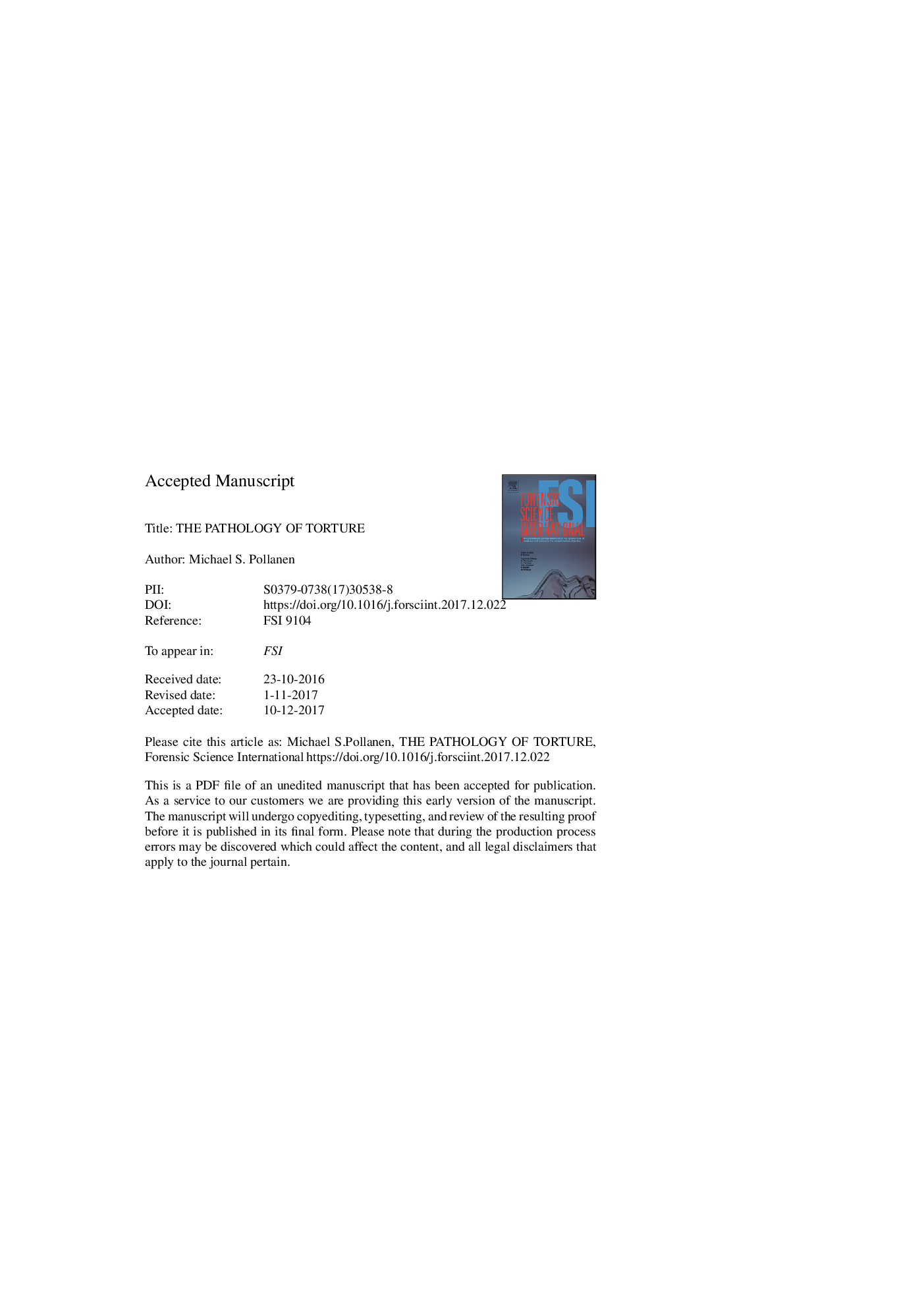| کد مقاله | کد نشریه | سال انتشار | مقاله انگلیسی | نسخه تمام متن |
|---|---|---|---|---|
| 6551290 | 1421966 | 2018 | 50 صفحه PDF | دانلود رایگان |
عنوان انگلیسی مقاله ISI
The pathology of torture
ترجمه فارسی عنوان
آسیب شناسی شکنجه
دانلود مقاله + سفارش ترجمه
دانلود مقاله ISI انگلیسی
رایگان برای ایرانیان
کلمات کلیدی
مرگ در زندان، سندرم مفاصل، بدرفتاری بازداشت شدگان
ترجمه چکیده
افراد بازداشت شده ممکن است توسط بازیگران دولتی و تروریست ها مجازات شکنجه و اجرای غیرقانونی شوند. اما آسیب شناسی شکنجه به خوبی توصیف نشده است. این به دلیل عدم وجود کالبد شکافی در قربانیان شکنجه است که عمدتا به دلیل دفع جسد قربانیان توسط شکنجه آنان است. بر این اساس، علت مرگ زندانیانی که تحت شکنجه قرار دارند، اغلب موضوع گمانه زنی است و یا مبهم است. این مقاله خلاصه ای از آسیب شناسی شکنجه را بر اساس تجربیات خود در مورد اتخاذ تصادم قربانیان شکنجه ارائه می دهد. در کالبد شکافی، انواع مختلف آسیب های ناشی از اعتیاد دیده می شود، که اغلب به شدت اعمال می شود. با این حال، سه نوع تکرار مجدد تروما که از ویژگی های شکنجه هستند، توسط مجله شناخته شده است: (1) ضربه تهاجمی خفیف که به وسیله کبودی، آسیب های الگو و آسیب های داخلی مشخص می شود؛ (2) آسیب های الکتریکی و حرارتی؛ و (3) جراحات از موقعیت های استرس که از تعلیق طولانی رخ می دهد. شایعترین نوع شکنجه مرگبار، عوارض موضعی استرس در ارتباط با تعلیق بدن قربانی توسط اندام فوقانی یا پایین است. به عنوان مثال، تعلیق طولانی با حلق آویز کردن معکوس (تعلیق بدن قربانی توسط مچ دست یا ساعد با بازوهای عقب در مفصل شانه) می تواند بیش از حد کشش و نکروز عضلات شانه ایجاد کند و منجر به شکستگی میوگلوبینوریک کلیه شود. ضروری است که کلوزآپستی ها بر روی تمام زندانیانی که در زندان می میرند انجام شود تا تعیین شود آیا شکنجه در مرگ نقش داشته باشد یا خیر. علاوه بر این، ماهیت واقعی آسیب های ناشی از آن، اغلب باقی می ماند مگر اینکه یک محرک تخریب عضلانی انجام شود. به طور خاص، تشخیص پشت، اندام و کف پا، و همچنین شانه ها و زانو ها برای تعیین اینکه آیا اشکال خاصی از شکنجه استفاده شده است، ضروری است. این به ویژه برای عوارض کشنده موقعیت استرس است. به دنبال حقیقت در مورد پیامدهای پزشکی شکنجه مرگبار، آگاهی از آسیب های مربوط به شکنجه را افزایش می دهد، به بازسازی مجدد شکنجه ها کمک می کند و اقدامات انسانی قانونی را تقویت می کند.
موضوعات مرتبط
مهندسی و علوم پایه
شیمی
شیمی آنالیزی یا شیمی تجزیه
چکیده انگلیسی
Detainees may be subjected to torture and extra-judicial execution by State actors and terrorists. But, the pathology of torture has not been well-described. This is due to the lack of autopsies performed on victims of torture, mostly due to the disposal of the bodies of the victims by their torturers. On this basis, the cause of death of detainees subjected to torture is often a matter of speculation or remains obscure. This paper provides an overview of the pathology of torture based on the authour's experience with the autopsies of torture victims. At autopsy, many different types of inflicted injuries may be observed, often ranging in severity. However, three recurrent patterns of trauma that are the hallmarks of torture were recognized by the authour: (1) blunt impact trauma characterized by bruises, patterned injuries, and internal injuries; (2) electrical and thermal injuries; and (3) injuries from stress positions that occur from prolonged suspension. The most under-recognized form of fatal torture are the complications of stress positions related to suspension of the victim's body by the upper, or lower extremities. For example, prolonged suspension by reverse hanging (suspension of the victim's body by the wrists or forearms with the arms extended backward at the shoulder joint) can cause over-stretching and necrosis of the muscles of the shoulder, resulting in fatal myoglobinuric renal failure. It is essential that autopsies be performed on all detainees who die in custody, to determine if torture played a role in death. Furthermore, the true nature of the injuries sustained often remains obscure unless a musculocutaneous dissection is performed. Specifically, dissection of the back, limbs and the soles of the feet, as well as the shoulders and knees is essential to determine if specific forms of torture have been applied. This is especially true for fatal complications of stress positions. Seeking the truth about the medical consequences of fatal torture will raise awareness about torture-related injuries, assist in rehabilitation of torture survivors, and strengthen forensic humanitarian action.
ناشر
Database: Elsevier - ScienceDirect (ساینس دایرکت)
Journal: Forensic Science International - Volume 284, March 2018, Pages 85-96
Journal: Forensic Science International - Volume 284, March 2018, Pages 85-96
نویسندگان
Michael S. Pollanen,
